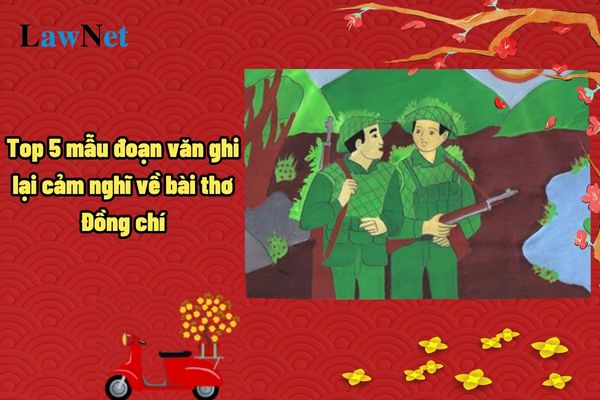What are the top 5 sample paragraphs showing thoughts on the Poem “Đồng chí”? What poems may be selected for the 8th-grade Literature curriculum in Vietnam apart from the poem "Đồng chí"?
What are the top 5 sample paragraphs showing thoughts on the Poem “Đồng chí”?
8th-grade students can refer to the following top 5 sample paragraphs showing thoughts on the Poem “Đồng chí”:
|
Top 5 sample paragraphs showing thoughts on the Poem “Đồng chí” 1. Profound Comradeship: |
*Note: Information is for reference purposes only./.

What are the top 5 sample paragraphs showing thoughts on the Poem “Đồng chí”? What poems may be selected for the 8th-grade Literature curriculum in Vietnam apart from the poem "Đồng chí"? (Image from the Internet)
What poems may be selected for the 8th-grade Literature curriculum in Vietnam apart from the poem "Đồng chí"?
According to Section 9 of the general education literature curriculum issued in Circular 32/2018/TT-BGDDT:
GRADE 8 AND GRADE 9
Stories, Novels
- Bắt sấu rừng U Minh Hạ (Son Nam)
- The Last Leaf (O. Henry)
- Chiếc lược ngà (Nguyen Quang Sang)
- Chuyện chiếc ấm sứt vòi (Tran Duc Tien)
- Đá trổ bông (Nguyen Ngoc Tu)
- Twenty Thousand Leagues Under the Sea (J. Verne)
- The Little Prince (Antoine de Saint-Exupery)
- Tinh thần thể dục (Nguyen Cong Hoan)
- Làng (Kim Lan)
- Lão Hạc (Nam Cao)
- Chuyện người con gái Nam Xương (Nguyen Du)
- Những ngôi sao xa xôi (Le Minh Khue)
- Robinson Crusoe (D. Defoe)
- Sherlock Holmes (A. Doyle)
- Tôi đi học (Thanh Tinh)
- Tuổi thơ dữ dội (Phung Quan)
- Vũ trung tuỳ bút (Pham Dinh Ho)
- ...
Poems, Folk Songs, Nom Verse Stories
- Bánh trôi nước, Mời trầu (Ho Xuan Huong)
- Bếp lửa (Bang Viet)
- Folk songs about people, society
- Chân quê, Không đề (Nguyen Binh)
- The Wolf and the Lamb, The Grasshopper and the Ant (J. La Fontaine)
- The Road Not Taken (R. Frost)
- Đây mùa thu tới (Xuan Dieu)
- Đồng chí (Chinh Huu)
- Hoàng Hạc lâu (Thoi Hieu)
- Hội Tây, Khóc Dương Khuê (Nguyen Khuyen)
- Khúc hát ru những em bé lớn trên lưng mẹ (Nguyen Khoa Diem)
- Lục Vân Tiên (Nguyen Dinh Chieu)
- Mộ (Ho Chi Minh)
- Mùa xuân nho nhỏ (Thanh Hai)
- Nam quốc sơn hà (Ly Dynasty)
- Nói với con (Y Phuong)
- Ngôn chí số 20, Thuật hứng 24 (Nguyen Trai)
- Ông đồ (Vu Dinh Lien)
- Qua Đèo Ngang (Ba Huyen Thanh Quan)
- Sang thu (Huu Thinh)
- Thuốc đắng (Mai Van Phan)
- Mẹ Tơm (To Huu)
- Tống biệt (Tan Da)
- Truyện Kiều (Nguyen Du)
- Vịnh khoa thi Hương (Tran Te Xuong)
- ...
What are the general orientations in teaching methods for the 8th-grade Literature curriculum in Vietnam?
Under the General Education Program in Literature issued with Circular 32/2018/TT-BGDDT, the general orientations in teaching methods for the 8th-grade Literature curriculum in Vietnam are as follows:
The Literature curriculum utilizes education methods oriented toward integrated and differentiated teaching; diversifying educational methods, means, and organizational forms; promoting active, proactive, and creative learning, applying the knowledge and skills of students.
- Based on the program, teachers proactively and flexibly build and organize lessons according to the following orientations:
+ Implement intra-disciplinary integration requirements (both knowledge and skills), interdisciplinary integration, and integrate priority education content (cross-disciplinary); implement differentiated teaching according to student subjects at all levels and differentiation contributing to career orientation in high school education.
+ Train students in methods of reading, writing, speaking, and listening; practice, experience in receiving and applying knowledge of the Vietnamese language and literature through learning activities in and out of the classroom; focus on using teaching means, overcoming the traditional reading and copying teaching style, developing thinking, training skillful use of means for students.
+ Enhance and promote student activeness and self-reliance; allocate ample time for students to study textbooks and learning materials, practice, conduct presentations, discussions, and defend learning results to enable students to read, write, speak, and listen according to varying demands and levels; assess and evaluate student task fulfillment in their learning tasks.

